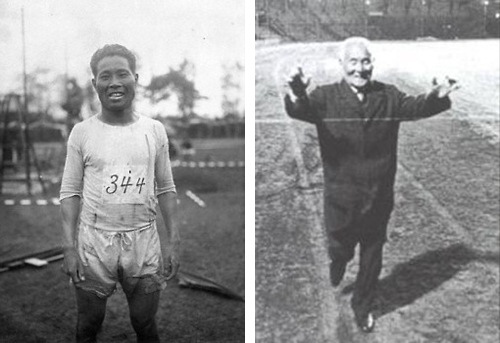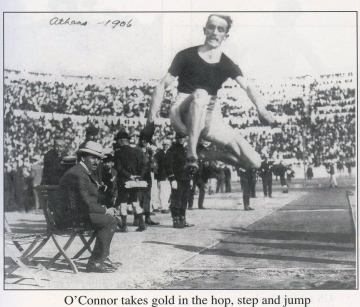Ok, here is what happened, the games of the VI Olympiad had been awarded. In 1912 work on the Olympic Stadium designed to seat 18,000 spectators began. On 8 June 1913 it was dedicated (pictured) with 60,000 people in attendance and 10,000 pigeons released. The issue of course was timing and location. The games of course would have occurred in 1916 in the middle of World War I, the location as shown by the flag of the German Empire was to have been Berlin.
There the games of the VI Olympiad never took place and it was 20 years before Berlin got to host their games. The Deutches Stadion built for the 1916 bid was used for football matches but was closed in 1934 with the arrival of the Olympic Stadium.
Budapest had initially been chosen to host the 1920 Games over Amsterdam and Lyon, however as they were part of the German Allies the Austro-Hungarian Empire they were not suitable to host the subsequent games. Therefore it fell upon the Belgian city of Antwerp to help that nation and the world recover from the trench warfare that had ravished that land.
So on with the stats
Nations 29 (+1)
Competitors 2627 (220)
Sports 22 (+8)
Events 154 (+52)
20 April - 12 September 1920 hosted by Antwerp, Belgium
The IOC left which countries should be invited up to the hosts, therefore the athletes of the former Axis powers Germany, Austria, Hungary, Bulgaria and Turkey were not invited.
The redrawn map of Europe did have the opportunity for new nations to join the Olympic family in Antwerp. But only Estonia took on that mantle for Europe. Czechoslovakia took on the mantle of Bohemia who had competed pre-war. Also from Europe the Kingdom of Serbs, Croats and Slovenes (later to be known as Yugoslavia) and Monaco took part for the first time, as did the newly independent Finland who had taken part as the Russian Grand Duchy of Finland before. Brazil and Argentina were also new countries, and having competed as Australasia, New Zealand competed for the first time as as a separate entity.
Post War a new flag
In June 1914 at the IOC congress Baron Pierre de Coubertin had approval for him emblem of five interlocking rings as the official symbol of the Olympic Games. With the intervention of war it appeared for the first time in Antwerp on a white back ground to represent peace.
In 1931 de Coubertin said:
"The Olympic flag ... has a white background, with five interlaced rings in the centre: blue, yellow, black, green and red ... This design is symbolic ; it represents the five inhabited continents of the world, united by Olympism, while the six colors are those that appear on all the national flags of the world at the present time."
The original flag as pictured, went missing after the games and a new flag was used from the next Games and passed on to the next Summer Games Host until 1988 (when it was retired), but also up until the 1952 Winter Games before they winter Olympiads got their own flag to pass on. However, for the entire use of that 1924 flag being used it was known as the "Antwerp Flag" in honour of its first appearance.
...and a new Oath
The Olympic Oath was first muted in 1906 but didn't appear in the opening ceremony until swimmer, water polo player and Epée Fencer Victor Boin uttered the following words.
We swear. We will take part in the Olympic Games in a spirit of chivalry, for the honour of our country and for the glory of sport.
Boin should really be in that infamous list of ten famous Belgians, but rarely do people remember who took the oath on behalf of the athletes, from 1972 also the officials.
However, Boin won three medals across three Olympiad in two sports from 1908 to 1920. Silver then Bronze in the water polo, followed by a silver in the team epée in 1920.
New sports
Ice Hockey was the only new sport at the 1920 Games and along with Ice Skating which had returned from the London 1908 were a precursor to the new innovation that would happen four years later in Chamonix, France with the I Winter Olympiad.
The eventual winners were Canada (pictured) in the shape of the Winnepeg Falcons. The team included future Stanley Cup winners Frank Frederickson and Haldor Halderson. Seven of the eight man team were of Icelandic origin, as well as Frederickson and Halderson, Robert Benson, Walter Byron, Chris Fridfinnson, Magnus Goodman and Konrad Johanneson had some or total Icelandic ancestors. Only Alan Woodman and coach W.A. Hewitt were except from the viking blood.
The team they beat in the final were USA.
The flying Finn
A 23 year old from Turku in Finland was to start what was to be the most successful Olypic career of a distance runner. He still ties the most Olympic gold medals with a sprinter Carl Lewis, gymnast Larisa Latynina and swimmer Mark Spitz only Michael Phelps has won more.
In 1920 Paavo Nurmi took three gold medals in the 10,000m, Individual Cross-Country and Team Cross-Country. He was also to take silver in the 500om.
In 1924 he went on to take 5 golds 1500m, 5000m, 3000m team race, individual and team cross country. He also came first in both the semi-final and final races in the 3000m team race, as well as his semi-finals in both the 1500m and 5000m, meaning he ran seven races, for a total of 26,000m, and won them all. He had also been entered in the 10,000m but the Finnish delegation fearing for his health withdrew him from what would have been his last race of the Olympics for a possible 6th gold. He returned to Finland angry and 56 days after the Olympic 10,000m winner, his compatriot, Ville Ritola ran a new world record to win gold he smashed it by a further 17 seconds.
He followed that up with another gold in the 10,000m with silvers in the 5000m and 3000m steeplechase in 1928. He would have been going for a 3rd 10,000m gold and the Marathon in 1932 but for a challenge from the Swedes that he had been paid too much in expenses to race in Germany and therefore broke the amateur rules.
An event in two countries and a first medal on ***** soil
For a unique Olympic moment we turn to the 12-foot dinghy competition. The second race was nullified at Ostend due to a tidal current moving the marks. There wasn't time to reschedule the race, but as both the contesting boats were from the Netherlands the final race took place in Amsterdam. The only time an Olympic event took place in more than one country and the first Olympic competition held by the Dutch a whole 8 years before their own Olympics.
See also: my full list of past Olympicss
















